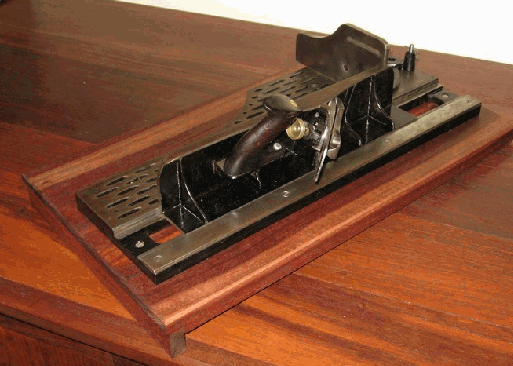 Needs Pictures: 0
Needs Pictures: 0
Results 16 to 30 of 81
Thread: Advice on Japanning
-
27th April 2023, 12:50 PM #16
 Senior Member
Senior Member











- Join Date
- Apr 2020
- Location
- USA
- Posts
- 122

The brand your friend recommended is a modern synthetic resin. Mixing it with asphalt to tint it should work, but it's not a traditional japanning. Should it matter? No, but one might as well use a spray can and call it the day.
Before synthetic products, most varnishes were composed of a drying oil (linseed oil) , a resin (e.g. Damar), a solvent (turpentine), colorant, and maybe a metallic salt to speed up drying. There's a big field of exploration there, in particular wood finishes. The particular case of the bakeable black metal paint (japanning) is but one example.
You guys have pretty exotic wood species there, it'd be interesting to see how they finish with pre-industrial varnishes.
Rafael
P. S. The link David mentioned is to a document prepared by a Ford model T collectors club. It's a long read, but one can skip until the black japanning part, formulas F-101 and F-102, which would be nice to get a hold of, by the way.
P-R
-
27th April 2023 12:50 PM # ADSGoogle Adsense Advertisement
- Join Date
- Always
- Location
- Advertising world
- Posts
- Many
-
28th April 2023, 10:51 AM #17
 Visit www.inthewoodshop.com for tutorials on constructing handtools, handtool reviews, and my trials and tribulations with furniture builds.
Visit www.inthewoodshop.com for tutorials on constructing handtools, handtool reviews, and my trials and tribulations with furniture builds.
-
28th April 2023, 12:00 PM #18
 GOLD MEMBER
GOLD MEMBER











- Join Date
- Nov 2007
- Location
- melbourne australia
- Posts
- 2,645
-
28th April 2023, 12:02 PM #19
 GOLD MEMBER
GOLD MEMBER











- Join Date
- Mar 2010
- Location
- US
- Posts
- 3,132

I didn't pay much attention to this yesterday, at least not as much as I should have.
McCloskey's spar varnish is an actual alkyd varnish.
What Steven said doesn't make sense, though. To do actual jappaning with durability just takes mixing:
* gilsonite (not expensive- this is powdered asphaltum. I couldn't remember what I had, but looked in my shelves yesterday - four ounces of gilsonite, which is probably enough to do 25 planes. it didn't cost enough to remember what the price was)
* linseed oil (doesn't need to be special, the baking is going to make the whole thing cure no matter what)
* pine rosin (very cheap - a small fraction of the cost of shellac) if the japanning is to be a little harder like that on stanley planes
* turpentine (doesn't need to be the good stuff, just turpentine. Mineral spirits would probably even work).
I'm sure I bought gilsonite with the intention to japan a plane, but I've just not had the reason to. Now that I've made varnish, the whole setup makes more sense. Asphaltum is somewhat ideal because it's cheap and it's also a resin, so it will become part of the varnish instead of just being a colorant. if it's not cooked at a temperature where it fuses, then it's just floating free.
roofing tar may have some kind of oil industry offshoot that's asphaltum or something similar.
the coming understanding of varnishing is probably going to make this a whole lot better understood than it has been.
....
just as an aside, the marine industry is probably the last group making and selling alkyd varnishes in the US. Most of the marine varnishes are focused on UV protection to make the finish look good and last as long as possible (I understand nothing in the world of boats lasts long, though). i have epifanes. It would probably be fine as japanning with anything tinting it black. it will dry relatively hard, but be durable, and it sticks to things like a thinned epoxy (all varnish does).
I don't know why stephen would've believed that japan driers were used on planes. They would've been baked because there's no way stanley would've had the tolerance to wait for actual varnish to harden.
Heating a marine varnish to dry it is also a little strange, but it would certainly dry it faster. Alkyd varnishes with driers don't really need that help, though - it risks cracking.
Everything that I'm aware of here sold for home use is now a spare urethane made to seem like a varnish. I've used that on wood, but can't remember anything other than that it flaked off after a few seasons. In that way, it was not like varnish.
(I looked up gilsonite - it's $8 for four ounces - it's natural asphaltum from utah - even more strange that steven would think it's expensive because that's where he was from if I recall).
...........
If anyone uses good clean raw linseed oil and makes their own mix, there would be no problem in making too much. if it was stored in a container that was more than half full, it would never cure on its own.
Maybe the idea of tracking down the ingredients seems like a lot of work, but through the lens of having cooked rosin and oils separately and then combining them to make varnish, it's pretty simple - the only issue is the stink of baking it and the need to get it to a temperature that would the oils and resins (I've seen 400 and 450F both mentioned).
-
28th April 2023, 12:08 PM #20
 GOLD MEMBER
GOLD MEMBER











- Join Date
- Mar 2010
- Location
- US
- Posts
- 3,132

I gather what raffo is saying - the lack of actually japanning things is a lack of information and bad sources. Stephen gave a lot of inaccurate info in whatever derek copied there. Would it have led to derek actually making japanning? probably not. But it would've kept me from making japanning.
The various things available to woodworkers that dance around just making japanning and don't clue a reader in to just getting a recipe to do it (which would've been dead common 125 years ago) is also unhelpful. If you asked people here about pontypool when it was first discussed, most people probably thought it was japanning (i did).
Too bad - it's literally been a 15 year missed opportunity because a few who would've known didn't care to speak up and everyone else ran around operating on bad information when there are scads of older books with simple recipes for an asphaltum based baking varnish.
-
28th April 2023, 02:01 PM #21
 Senior Member
Senior Member











- Join Date
- Apr 2020
- Location
- USA
- Posts
- 122

I'm aware where you are, I even pointed out that you have some interesting wood species there.
I've got Stephen's book on paints. I located the reference on using marine varnish. It's offered as a substitute to using traditional recipes.
My comment was tongue in cheek. One can go all the way and use traditional varnish recipes, or buy a can of poly. One can buy raw lumber and process it by hand, or get it S4S. Somewhere in between is ok too. Everyone of us is motivated by different things. The marine varnish option is one of those in betweens, not one that motivates me. Using a traditional japan black recipe does.
By the way, a tool aficionado I met during the pandemic, https://www.instagram.com/mwebster51, restores planes to a high degree, he uses powder coating nowadays. I think he chooses not to use japanning.
Rafael
-
28th April 2023, 05:54 PM #22

Raphael, my thought on restoring planes and tools is that there are several possible aims:
1. restore to original - use the identical products as when it was first made.
2. restore to look as close to the original as possible - use very similar but not identical products as when it was first made.
3. restore to look as close to original as possible, but not use the same products.
4. restore to look good - example use car engine paint.
5. restore to be as durable as possible - example powder coat.
I would argue that the mix I used fits with #3. It looks damn close to the finish on an original Stanley plane ... which is definitely not the case with #4 and #5. In fact, the first three can look identical.
Japanning mix as #3 - textured, smooth and body ...
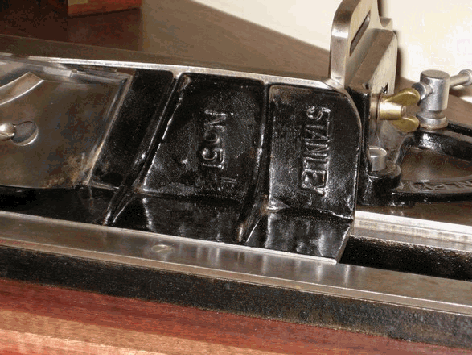
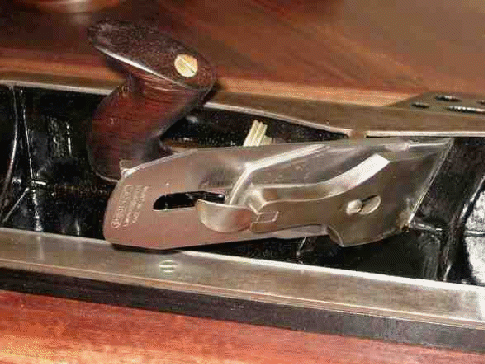

A painted #605 plane (which needed to be rescued from a junk pile) - flat (thin) and even coat ...
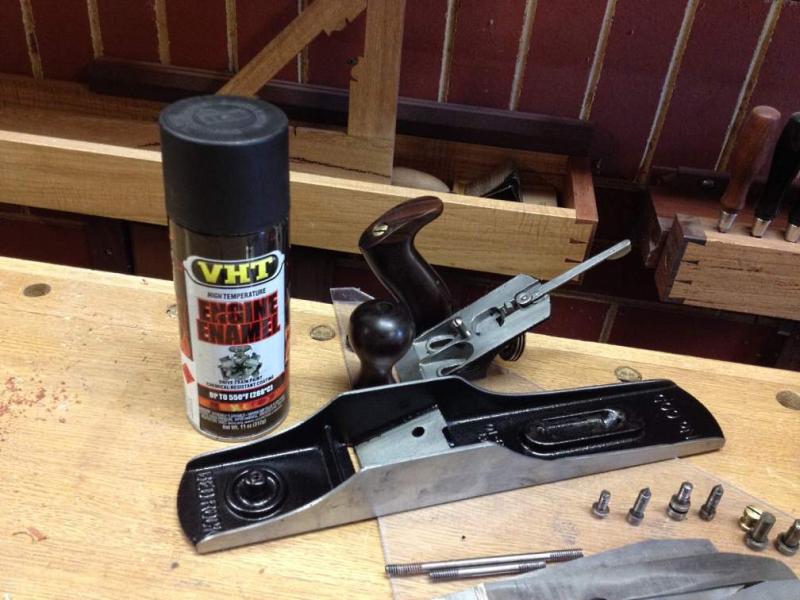
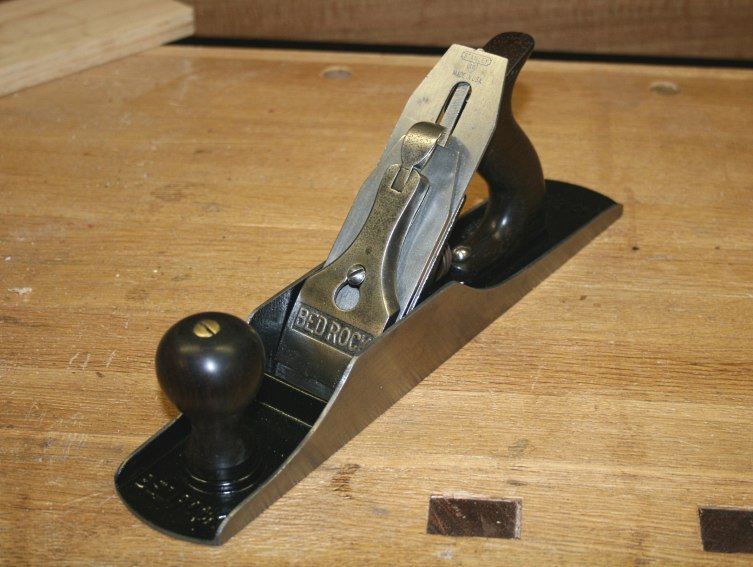
Regards from Perth
DerekVisit www.inthewoodshop.com for tutorials on constructing handtools, handtool reviews, and my trials and tribulations with furniture builds.
-
1st May 2023, 11:53 AM #23
 GOLD MEMBER
GOLD MEMBER











- Join Date
- Mar 2010
- Location
- US
- Posts
- 3,132

Follow up on driers or not. First, if someone is using a completed boat varnish and adding resins, the varnish itself will have driers in it.
if, on the other hand, someone wants to make a baking varnish without driers, I found some clarity today in the 1912 german american varnish book.
* asphaltum is a natural product in the US. it's more of a dark brown
* there are other natural asphaltum deposits in the world that are black
* bitumen has some similarity to asphaltum (I guess this is roof tar) but it's a byproduct of petroleum and melts around 160F when it's roofing tar, which is probably handy for site work
* Utah asphaltum (gilsonite) and probably some other natural asphaltum resins have a much higher melting point - 165-200C
* in general, the harder a resin is, the higher the melting point - or the converse, the higher the melting point, the harder the resin will be. I'm sure there are exceptions, but I don't see many in terms of varnishes
* whatever the resin is like, it sort of dictates without hardeners or driers how hard a varnish will be. So if you have a very soft pine resin that melts easily or slowly settles at room temperature, the resulting varnish will be like that.
The german american varnish book flatly states that if using asphaltum as a byproduct of the petroleum industry, and such a resin is relatively soft and easily influenced by temperature, the varnish will not be hard and metallic dryers will be needed to make it hard. if the asphaltum is natural, then dryers won't be needed.
One of the recipes as stated in the german american book is literally "benzine" and asphaltum (naptha = benzine) - apparently nothing more than using naptha to thin asphaltum and then baking it off leaving the asphaltum as a thin layer of resin.
it's hard to resist delving into this a little further and trying these recipes.
-
4th May 2023, 01:52 AM #24
 GOLD MEMBER
GOLD MEMBER











- Join Date
- Mar 2010
- Location
- US
- Posts
- 3,132

I didn't look into this earlier, but would've been surprised to find that an alkyd resin boat varnish wasn't available in australia. I was able to find it pretty easily - probably available on the ground in any populated area or through a pro paint supplier. We have the same issue here - most places can't ship (or receive via shipping to residence to put it more accurately) the varnish stephen mentioned, but it can be bought on the ground here.
A little weird since one would assume that getting it on the ground requires shipping.
It is more expensive to buy marine varnish and tint it with bitumen than it is to just buy gilsonite (finely ground at a couple of bucks an ounce in smaller quantities, or $1 an ounce roughly at art supply here for a pound. Still puzzled by that comment from stephen, but maybe he was referring to some specialty product that had gilsonite in it and didn't know that gilsonite itself is really cheap - far cheaper than any similar hardness and melting point resin for varnish, and soluble in turpentine and naptha, so it won't stay solid and dull a finish).
I found something worth thinking about for anyone who even so much puts bitumen in varnish and heats to 220F. Bitumen and asphalt can have varying amounts of hydrogen sulfide in them. it isn't released *unless you heat it*.
None of this stuff should ever be baked indoors. You can smell hydrogen sulfide (stinky like sulfur), but the SDS sheets say this is unreliable because it's masked by the smell of tar and asphalt in some cases until it's at acutely toxic or fatal levels.
-
4th May 2023, 01:56 AM #25
 GOLD MEMBER
GOLD MEMBER











- Join Date
- Mar 2010
- Location
- US
- Posts
- 3,132

(hydrogen sulfide can be created in manure pits and storage at farms, and is a near instant killer often leading to multiple deaths when someone slumps over at the edge of a manure pit and a well meaning follower-on attempts to rush in to find out what's going on. This is a known thing and has been for 40 years, but deaths still aren't that uncommon when people fail to contemplate what could be going on in a rush situation).
"Breathing hydrogen sulfide at levels above 600 ppm can cause death in just one or two breaths, according to NASD."
3 men die in manure pit: Here's why it's a 'death trap. | Live Science
-
7th May 2023, 05:01 AM #26
 GOLD MEMBER
GOLD MEMBER











- Join Date
- Mar 2010
- Location
- US
- Posts
- 3,132
 Gilsonite, blo, turpentine
Gilsonite, blo, turpentine
Nothing else. About 50% turps, 30% gilsonite and 20% blo.
20230506_132019.jpg
20230506_132005.jpg
Bakes to 450f, no worries, it won't run at that temp. I have a feeling it fuses on the tool.
Lower temps and it will remain a little tacky. Will continue to harden over time due to driers in blo, but driers are about a fifth in the mix vs a commercial boat varnish.
Thinn coats are preferable. Three on this at this point and the japanning is thin compared to how it looks. That was also true of the original. Will scrape the bed after 1 more coat.
Dead easy and cheap once it's known how it works and why a high temp is important.
Substituting petroleum bitumen will prevent a hard finish and lead to smoke at a fusing temperature. Do yourself a favor and locate a natural asphaltum like gilsonite. There are others from Asia that are more black or black with a very slight bluish hue.
-
7th May 2023, 08:53 AM #27
 GOLD MEMBER
GOLD MEMBER











- Join Date
- Mar 2010
- Location
- US
- Posts
- 3,132

Here's my thoughts on this a little bit further revised. I couldn't find a brush at first because I don't keep acid brushes around and my natural bristle brushes are 2" or more, including the obnoxious cheap chip brushes.
I have real varnish brushes, but we're not going there with this stuff, and they're also too big and made to hold a volume of varnish to brush out.
I found an acid brush in the toolbox, the nature of one or two getting away from the main bag and if you're disorganized like me, the prize of being disorganized is that you can usually go to the well find one or two of something that started as 50.
I brushed on the last coat - that makes four, but I'm being stingy on the coats because i don't want them to run and I did try the spirit version of this (turpentine and asphaltum only), but it bubbled and then made a very shellac like hard layer that was easy to scratch off.
the varnish version with oil linked in is from another planet - it's hard enough, but not that hard - time will tell where the terminal hardness goes, it'll be a while before it gets there, but it's kind of finish where if you scratched an awl across it, it would leave a tiny thin line with nothing letting go of the metal and no shattering of the finish like you will get from paint. I could say "it's the real deal", but of course it is. it's asphaltum, turpentine and oil, the most basic of mixes with the only variables in the bake only type being how much driers and whether or not the solvent is turpentine or it's mostly benzine (naptha) with turpentine. The way it lays out in a deep looking gloss with only a very thin layer is magical.
this is a feature of varnish in general above and beyond a lot of other faster drying finishes, and is why I'm reopening my book on making varnishes now that steve has brought up "hey, you know you can still get resins harder than pine rosin and get the same kind of depth without a heavy build and get a harder finish, they're just going to require a little more skill as the hardness of the resin increases".
Critical to this was knowing the melting temperature and knowing that 400F may be too close to it for fusion of oil and resin to occur on the tool, contrary to a lot of thumbs down-ish stuff from others saying they don't want to heat a plane above 350F because it will take on a straw hue (that's superficial and can be removed even with a cheap rubber rubbing block.)
I understood the value of the oil and resins fusing before, but just didn't know that asphaltum was actually a resin that could be fused with oil, and would at the same time have good hardness as a resin (we're all familiar with road tar in the summer - but that's bitumen and not gilsonite).
I made a four ounce jar of this. It would probably do 10 smoothing planes or 25 spokeshaves. The cost of materials in that jar are about $2.50 of gilsonite, 25 cents of hardware store BLO (again, just to have a little bit of driers in it for insurance that even if the drying wasn't complete due to heat, it would be accelerated with oxygen), and i did use expensive turpentine, so about $2 worth of that. It wouldn't be necessary to use good turpentine, though. A quart of the pulpwood industry byproduct stuff is findable at home dept here for about 9 bucks vs. the 45 or so for a quart of the good stuff. The good stuff smells like pine cleaner. The cheat stuff smells like pine cleaner with a hint of gasoline and used motor oil in it - enough to make it not smell that great.
the fusing process created no smoke, and raffo as well as reading other sources allowed me to find that the sulfur in gilsonite is there (hydro sulfide potential) but it isn't much compared to roofing tar - about 0.2% or so. Roofing tar can be up to 40% sulfur - keep that in mind - along with the fact that it's a poor choice for anything other than mixing into another hydrocarbon solvent varnish - you're just using it as a colorant and a better way to go would just be to tint real varnish with micronized furnace black. It could be risky to heat boat varnish to a temperature high enough to fuse the bitumen because the dryer content will be a lot higher and you could end up with cracking.
You have the ability to get gilsonite in australia mail order from art supply places - I already checked. It's not expensive.
I will spare you further on options if you wanted to make a version of this that could be laid on cold like a boat varnish, because it would require running (melting) the gilsonite and then preparing linseed oil by heating and then fusing the two, but if you really wanted to do that with a raw oil, you could have asphaltum japanning that would last 75 years in a jar, even thinned with turpentine. you could add a couple of drops of japan drier to it later and mix and then it would dry in a couple of days or a little faster if left in the sun. I prefer the baking so far, though the idea of having a version of this that could be used to paint metal in general (hardware, etc) with a strong drier to get a good hard cure without heat does have some merit.
anyone on here ever had the question "what really sticks to bare metal if you're painting". if you're in my boat, you've primed and then painted metal work and it holds up OK as long as nothing rubs against it.
the answer is varnish - varnish sticks to metal, and even if you have a little bit of stray oil on the surface of something, it won't affect adhesion much. I didn't chemical clean or blast this spokeshave, just wire wheeled it. No bubbles or anything due to that.
-
7th May 2023, 09:12 AM #28
 Senior Member
Senior Member











- Join Date
- Apr 2020
- Location
- USA
- Posts
- 122

I was wondering about what was necessary to prepare the tool before applying the varnish. Perhaps it's not something that one should go overboard about. I've a Stanley #S4 with no japanning on it that is a good candidate.
-
7th May 2023, 09:14 AM #29
 GOLD MEMBER
GOLD MEMBER











- Join Date
- Mar 2010
- Location
- US
- Posts
- 3,132

short story long, we've made something easy hard by having a bunch of people who don't too much understand the underlying process of varnishing coming up with a bunch of work arounds or processes that really don't solve much..
..when literally reading a book from 1910 for 15 minutes would give us good dose of reality and accurate rudder tending instead of what we seem to do - turn to gurus.
it may seem very negative, but let's be honest - the turn that forums and youtube and blogs have taken us on has been inaccurate, led to a lot of preening and none of us really needs to reinvent a wheel that existed in 1910 and was hundreds of years refined. Even gilsonite had been around for half a century before that.
----------
complete separate aside - if you ever do get into any of the strong spar finishes that have really toxic looking SDS sheets and could cross your eyes a little, Bill also said that even though they can be irritating, as hobbyists, they're not really anything for us to be concerned with. so if you still want to just tint other finishes, there's that.
I did use epifanes before making my own varnish - it's very aromatic and not in a pleasant way. Tinted with lamp or furnace black and in gloss offering, it would do a pretty convincing japanning imitation. But to get the can and the thinner (which is probably needed), is again - far more expensive than just making the real thing with linseed oil you probably already have, and naptha or mineral spirits if you're too cheap to get turpentine, and gilsonite that's also about 9 euros equivalent in australia (your art stores think I need to see euros).
Do it right. maybe we could start a movement where we all start looking back a little further and creating a data trail of better information. I was relatively fond of stephen sheperd, but the narrative left behind in this case is beyond poor. He likely had good intentions, but it didn't work out and it so often doesn't when we turn to a chris schwarz, cherubini or stephen when public domain has a better answer at the end of a search.
-
7th May 2023, 09:38 AM #30
 GOLD MEMBER
GOLD MEMBER











- Join Date
- Mar 2010
- Location
- US
- Posts
- 3,132

It seems like if someone was worried about dirt or oils, wiping with the solvent that's in the japanning would be fine. No need for drying it off or anything nutty. Even scrubbing quickly with the linseed oil would be fine. I only wire brushed off the old japanning for aesthetic. Well, more accurately, wire brushed at 10,000 rpm.
Similar Threads
-
Re-Japanning
By Luke Maddux in forum ANTIQUE AND COLLECTABLE TOOLSReplies: 10Last Post: 31st May 2015, 07:34 PM -
Japanning again
By Peter57 in forum HAND TOOLS - UNPOWEREDReplies: 5Last Post: 5th July 2013, 01:10 PM -
DIY Japanning
By Polie in forum HAND TOOLS - UNPOWEREDReplies: 43Last Post: 18th April 2011, 12:09 PM -
Japanning replacement
By Wongdai in forum HAND TOOLS - UNPOWEREDReplies: 8Last Post: 1st July 2009, 04:27 PM -
DIY japanning
By jmk89 in forum HAND TOOLS - UNPOWEREDReplies: 17Last Post: 22nd October 2006, 03:28 PM



 Thanks:
Thanks:  Likes:
Likes:  Picture(s) thanks:
Picture(s) thanks: 
 Reply With Quote
Reply With Quote
